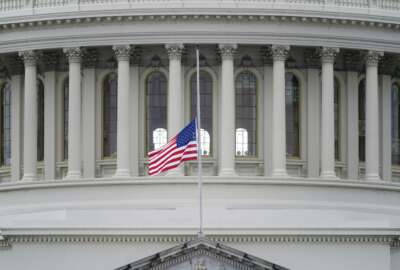
Postal reform bill could raise health premiums for federal workers, employee group warns
The Postal Service Reform Act, at least as it's currently written, proposes significant structural changes to the Federal Employees Health Benefits Program. An...
A bipartisan bill designed to bring desired financial relief to the U.S. Postal Service could have implications for the rest of the federal workforce, potentially raising health insurance costs for employees and retirees, an employee advocacy organization warns.
For the first time in years, momentum is building in Congress over postal legislative reform. The Postal Service Reform Act, which House Oversight and Reform Committee Chairman Carolyn Maloney (D-N.Y.) and Ranking Member James Comer (R-Ky.) introduced earlier this month, cleared the committee and has approval from Postmaster General Louis DeJoy himself.
Homeland Security and Governmental Affairs Committee Chairman Gary Peters (D-Mich.) and Ranking Member Rob Portman (R-Ohio) introduced a Senate companion last week. The bill has 20 Senate co-sponsors from both sides of the aisle.
Nearly all of the debate and discussion associated with the bill at this point has been focused on bringing financial stability to the Postal Service.
But the legislation, at least as it’s currently written, proposes serious structural changes to the Federal Employees Health Benefits Program (FEHBP), which provides insurance to roughly 8 million federal and postal workers, retirees and their families.
Without changes, the bill could raise FEHBP premiums for some, the National Active and Retired Federal Employees (NARFE) said in recent letters to House and Senate members.
The legislation would split the existing Federal Employees Health Benefits Program into two, creating a separate Postal Service Health Benefits Program for USPS employees and retirees.
The Postal Service Reform Act would separate 2 million postal workers and retirees from the federal program, creating a smaller, riskier pool of participants for FEHBP to cover, NARFE said.
FEHBP premiums are based on how much its participants use the health care system and the average costs for those services during a given year. Older employees with more health conditions tend to drive prices up, while younger, healthier members keep costs down.
The new legislation requires current postal workers to enroll in Medicare Part A and B when they reach age 65. It gives current retirees the option of enrolling in Medicare, waiving the usual late enrollment penalties. Medicare will pick up initial hospital and prescription costs, and the Postal Service will become the secondary payer.
But current retirees who choose not to opt into Medicare will stay in the FEHBP.
While this arrangement is designed to save the Postal Service billions over the next decade, NARFE worries it could raise premiums for federal employees and retirees still enrolled in the FEHBP. Those who are Medicare-eligible but choose not to enroll are some of the most expensive participants to insure.
“For those who don’t have Medicare, they’re older, they’re age 65 or [more], and you don’t have Medicare picking up the first dollar of coverage for you,” said John Hatton, NARFE’s legislative director. “Those costs to the FEHB program are much higher than average, and premiums are based on average costs. If you’re pulling out people who are less costly to insure and keeping those others who are more in the FEHB side, it could cause an increase in premiums.”
Allowing USPS to cherry-pick which individuals to insure also sets a dangerous precedent, NARFE said. Advocates of the FEHBP say the buying power of 8 million participants gives enrollees a variety of options at competitive rates. Reducing the size of the insurance pool and populating it with older, more expensive participants could diminish that buying power, NARFE said.
Still, it’s unclear at this stage how exactly the Postal Service Reform Act might impact FEHB premiums, and, if the bill does indeed raise costs for participants, what they might be.
“We see integrating postal workers more fully into Medicare as a vital component of putting the Postal Service on a more sound, long-term financial footing,” a senior Democratic aide on the House Oversight Committee told Federal News Network. “The committee is aware of concerns about the effect this could have on the Federal Employee Health Benefits Program and takes them very seriously. We will be working with the Office of Personnel Management and the Postal Service to address this issue, if necessary, as the bill moves to the floor.”
In a letter to Senate Homeland Security and Governmental Affairs Committee leadership, NARFE urged members to consider technical analysis and feedback from the Office of Personnel Management, which administers the FEHBP, before taking further action on the Postal Service Reform Act.
“OPM is working with Congress to address concerns involving how the healthcare provisions of the legislation will impact the cost and delivery of health care benefits and services for federal employees and other FEHBP beneficiaries,” Shelby Wagenseller, an OPM spokeswoman, told Federal News Network.
Proposed health benefits changes aren’t new
While Congress is moving with a new sense of urgency to bring legislative relief to USPS, this isn’t the first time it’s considered splitting the Postal Service from the FEHBP.
The health care provisions in this new bill are similar to those the Senate considered in 2012, when former Sens. Joe Lieberman (D-Conn.) and Scott Brown (R-Mass.), as well as Sens. Tom Carper (D-Del.) and Susan Collins (R-Maine), introduced the 21st Century Postal Service Act.
Like the current bill, the 2012 legislation split the FEHB into two to include a separate Postal Service Health Benefits Program for postal workers.
OPM previously found the arrangement would raise health insurance premiums by 10% for participants in the three largest FEHB plans, according to a 2012 article from the Hill.
The Senate excluded those provisions at the last minute and went on to pass the 2012 bill without the health benefits changes. The bill never cleared the House.
But this time, a broad coalition in Congress is eager to build off momentum from the last year, when service levels at USPS dipped and gained public attention.
Maloney and Comer introduced the bill together, and members are anxious to pass the first comprehensive postal reform legislation in 15 years. At an oversight committee markup earlier this month, Comer said the bill had “a good chance of becoming law.”
The Postal Service Reform Act also includes several changes that stakeholders, including NARFE, have long advocated.
The bill would eliminate the agency’s 2006 mandate to fund retiree health benefits well into the future, a significant cost for USPS, at least on paper. The agency has defaulted on billions of dollars in annual payments to the retiree health fund.
Eliminating the 2006 mandate and implementing the bill’s Medicare integration scheme alone would save the Postal Service $45.9 billion over the next decade, Peters and Portman, the Senate co-sponsors, have said.
The bill also maintains six-day delivery and requires USPS to publicly post weekly service data on its website.
“There’s a lot to like about this bill,” said Jessica Klement, NARFE’s staff vice president for policy and programs. “It is difficult to be in a position of continuing to ask for changes when this bill has broad bipartisan support and other stakeholder support. But again, they’re attempting to fix the Postal Service on the backs of something else. Before it was postal retirees, now it could be the entire FEHB program.”
NARFE believes members could change the language of the bill to prevent USPS from “cherry-picking” lower-cost postal employees and retirees to insure. Congress could also include safeguards within the text of the bill itself to ensure the FEHBP isn’t stuck with higher costs.
“That might reduce USPS cost savings, but you wouldn’t have to remove this entire piece from the bill for it to move forward,” Hatton said.
At this stage, Congress has plenty of opportunities to change the Postal Service Reform Act as its currently written.
And while the House Oversight and Reform Committee cleared the bill earlier the month, the House Ways and Means and Energy and Commerce Committees must mark up the bill as well. Both committees have jurisdiction over Medicare and may consider amendments.
But for NARFE, it’s worrisome that the House Oversight and Reform Committee, which has jurisdiction over the Postal Service and federal workforce, advanced the bill with little discussion — at least not publicly — about the legislation’s potential impact on the FEHBP.
“The Postal Service has been in a precarious financial position for over a decade,” Carolyn Maloney (D-N.Y.), chairman of the House Oversight and Reform Committee, said in a statement to Federal News Network. “I introduced the Postal Service Reform Act to help put the Postal Service on a sustainable financial footing for years into the future, and the bill has already received strong bipartisan support. I am also a strong advocate for federal employees and retirees, and I am working closely with stakeholders to ensure that the bill that passes the House addresses their concerns.”
The Senate Homeland Security and Governmental Affairs Committee has jurisdiction over the postal reform bill and hasn’t scheduled a markup yet.
A Senate committee aide said members are working closely with stakeholders about concerns with the bill and is open to all feedback.
Copyright © 2025 Federal News Network. All rights reserved. This website is not intended for users located within the European Economic Area.
Nicole Ogrysko is a reporter for Federal News Network focusing on the federal workforce and federal pay and benefits.
Follow @nogryskoWFED





